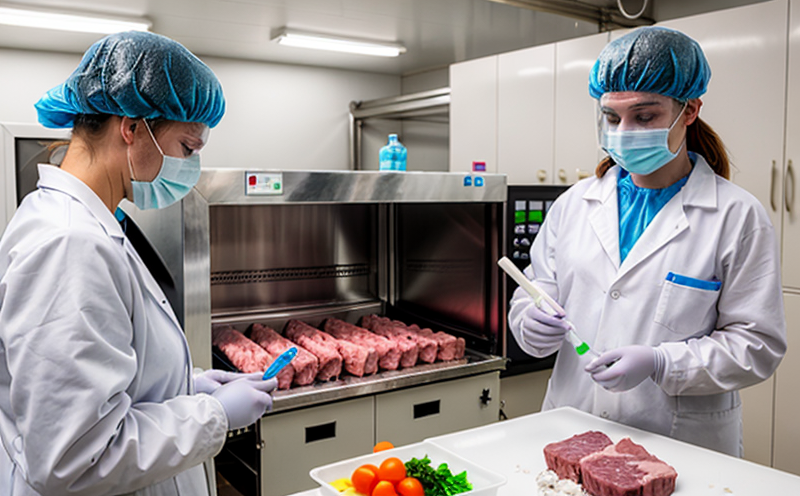Surface Hygiene Swab ATP Test
The Surface Hygiene Swab ATP (Adenosine Triphosphate) Test is a rapid and effective method used to assess the level of microbial contamination on surfaces, particularly in industries such as dairy, meat processing, pharmaceuticals, and food service. This test measures the total number of living microorganisms present by detecting the presence of ATP, the energy-carrying molecule essential for all life forms.
The ATP test is widely used because it provides quick results, typically within minutes to hours, compared to traditional culture-based methods which can take days. It helps in identifying surfaces that require cleaning and sanitation more effectively, thereby preventing cross-contamination risks and ensuring product quality.
For dairy and meat processing facilities, the significance of this test cannot be overstated due to the potential for contamination with pathogens like Listeria monocytogenes or Salmonella enterica. By implementing surface hygiene tests using ATP swabs, companies can monitor and maintain high standards of cleanliness across their production environments.
Technically speaking, the process involves collecting a sample from the surface in question by swabbing it, then transferring this swab to a lysis buffer that extracts ATP. This solution is subsequently analyzed using bioluminescence technology, which measures light produced when luciferin and luciferase are exposed to ATP.
The result of the test provides an index value representing the amount of microbial contamination, expressed in relative light units (RLU). Values above a certain threshold indicate unacceptable levels of microbial presence on the surface. These thresholds vary depending upon industry standards; for instance, ISO 14695 specifies cleanliness classes relevant to cleanroom environments.
This method offers significant advantages over conventional microbiological testing by providing real-time data rather than relying solely on post-production samples for analysis. It supports continuous improvement initiatives aimed at enhancing food safety protocols and overall hygiene standards within facilities.
| Industry Applications |
|---|
| Dairy Processing Meat Processing Pharmaceutical Manufacturing Hospital Hygiene Monitoring Food Service Facilities |
The ATP test finds extensive application across various sectors where surface hygiene is critical. In dairy processing, it ensures that equipment and packaging remain free from harmful bacteria. Meat processors use this technology to maintain the integrity of product quality by detecting any contamination early on in production processes.
Pharmaceutical manufacturers also benefit from implementing ATP swabs as part of their sterilization validation procedures. Hospitals employ these tests regularly to monitor cleanliness standards, especially in areas prone to infection risks like operating theaters and intensive care units.
Customer Impact and Satisfaction
- Enhanced Product Quality: By identifying contaminated surfaces promptly, companies can prevent the introduction of pathogens into products, leading to higher-quality goods.
- Improved Compliance: The ATP test aligns with regulatory requirements set forth by organizations such as FDA, USDA, and EU directives regarding food safety standards.
- Increased Efficiency: Quick results allow for immediate corrective actions without disrupting workflow or causing delays in production schedules.
- Better Hygiene Practices: Regular ATP testing encourages better cleaning practices among staff members who understand the importance of maintaining hygienic conditions.
Clients report higher levels of customer satisfaction when they see tangible improvements in their product safety and reliability. This is because consumers increasingly value transparency about how manufacturers ensure safe food products from farm to fork.
Moreover, adopting advanced technologies like ATP swab testing demonstrates a commitment to excellence among stakeholders including investors, employees, and regulatory bodies alike. It fosters trust between businesses and their customers while helping maintain competitive advantage in today’s marketplace.
International Acceptance and Recognition
- The ATP swab test is internationally recognized by organizations such as the International Organization for Standardization (ISO) under ISO 17295, which sets guidelines for microbiological examination of surfaces.
- The United States Department of Agriculture (USDA) and Food and Drug Administration (FDA) recommend using ATP bioluminescence technology for surface hygiene monitoring in food processing facilities.
Many countries around the world have adopted ISO 17295 as a national standard, ensuring consistency across borders when it comes to interpreting surface cleanliness metrics. This international consensus reinforces confidence in the reliability and accuracy of ATP testing methods globally.
The widespread acceptance of this technology reflects its proven ability to deliver precise, rapid results that help maintain high standards of hygiene and safety in diverse industries worldwide.





